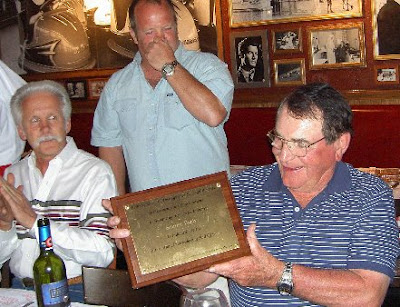
So here's the way the story goes...I'll tell the short version because it's an Irish story and you know how long they can be.
There once was an Irish blacksmith named Jack. He was a miserable man, and he spent his nights in the pub trying to make everyone around him miserable, too.
One night he made a deal for one more drink, but he had no money so it had to be paid for by the Devil.
The devil demanded to be paid back, but Jack tricked the Devil. That's never a good idea. The Devil promised Jack that he'd take his soul.
When the blacksmith died, he was refused admission to heaven for all his evil, selfish deeds, and foul moods. He was sent straight to the gates of hell.
Whom do you think was waiting for Jack?
The Devil was standing at the gates to Hell. He immediately recognized Jack as the Irish blacksmith who had cheated him. The devil crossed his arms and refused to let Jack into hell.
Where was Jack supposed to go? The Devil didn't care, but Jack had better get going. Jack pleaded for a coal from Hell's fires so he might see his way as he wandered out through the darkness.
The Devil granted his wish and squashed a glowing coal into a half-eaten turnip. He handed it to Jack with a smirk.
The grouchy old blacksmith wandered off and guess what? He wandered forevermore. He's still out there, they believe in Ireland.
Where was Jack supposed to go? The Devil didn't care, but Jack had better get going. Jack pleaded for a coal from Hell's fires so he might see his way as he wandered out through the darkness.
The Devil granted his wish and squashed a glowing coal into a half-eaten turnip. He handed it to Jack with a smirk.
The grouchy old blacksmith wandered off and guess what? He wandered forevermore. He's still out there, they believe in Ireland.
It's said that Jack's piece of glowing coal in a turnip could be seen across the Irish countryside at night as he wandered aimlessly, the ultimate ghost.
And of course, as a smith, Jack would have had the skill to keep the coal ember going. He made the most of the devil's generosity.
Irish children began to imitate Jack's lantern and Irish-American children switched from turnips to pumpkins on this side of the Atlantic.
And so it is that so many of us still place glowing vegetables on our doorsteps on Halloween to scare away the haunted souls...like Jack, the grumpy, cheapskate, old blacksmith who is out there somewhere, tonight.
And of course, as a smith, Jack would have had the skill to keep the coal ember going. He made the most of the devil's generosity.
Irish children began to imitate Jack's lantern and Irish-American children switched from turnips to pumpkins on this side of the Atlantic.
And so it is that so many of us still place glowing vegetables on our doorsteps on Halloween to scare away the haunted souls...like Jack, the grumpy, cheapskate, old blacksmith who is out there somewhere, tonight.
--Fran Jurga
 |
| Click here to add your email address to the Hoof Blog headlines list. You will receive an email, which you must click on to confirm you made this request. Thanks! |









